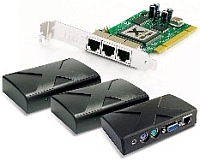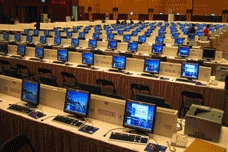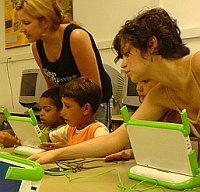Stephen Dukker, chief executive of NComputing, has a serious hating on One Laptop Per Child, but for many of the wrong reasons.
In August, when I read his rhetorical proclamation "Is the OLPC project doomed to failure?" I thought he was going to hone in on any number of Nicholas Negroponte's grand proclamations that are slowly showing false, like governments should buy millions of computers without first pilot testing, there's no need for an implementation plan, or children can learn learning without teacher training.
But instead, the former chief executive of eMachines took a whole other angle to try and knee-cap "$100 laptops":
Helping people in the developing world cross the digital divide is a fundamental act of decency and generosity... As laudable as this dream is, the ideal unfortunately runs counter to a fundamental fact of life: a computer cannot exist independent of basic economic realities.While he's right to say a computer needs a whole profit-driven ecosystem of support, from maintenance to connectivity, he's apparently not heard of DVD players, cell phones or radio if he thinks that electronics require a $200+ price point to generate healthy professional services around them.A computer is, rather, a creature of connectivity and collaboration. And, given the economic realities in the developing world, $200 computers cannot generate the profit essential for the creation of a robust IT ecosystem, which is essential to ensure successful deployment, ongoing operation and maintenance.
What all those electronics have in common, besides dropping prices well below $200, is the ability to repurpose them for commercial use. A cell phone can be rented to others, and its top-up cards are sold on ever corner. DVD players and DVD player mechanics cover every country to supply demanded entertainment, and radio stations & receivers have been solid technology-based businesses since the 1940's.
Stephen Dukker was really trying to introduce his own technology-based business, the thin-client model NComputing, and position it as an even-lower cost computing model for developing world governments. Instead of one-to-one computing, Stephen wants countries to equip schools with shared-access computer labs based around his company's non-CPU-based access terminals.
And he took this argument all the way to the Wall Street Journal where he tried to bust out a can of Whoop-Ass on Walter Bender, President, Software and Content, One Laptop Per Child. And "tried" is the operative word because Walter Bender put the uppity Stephen Dukker in his place by pointing out the major difference in approach.
Of course it is, but Dukker also is correct to say there is enormous costs that go with total saturation. As we've explored before, the real cost of OLPC implementation could be in excess of $1,000 per child, while just the hardware costs alone could bankrupt Nigeria. Yet NComputing isn't much cheaper either.Mr. Bender: Your choice of words describing our missions is interesting: "computer-assisted education." At OLPC, we'd say: "computer-enabled learning."
The OLPC approach is one of saturation: The children have access to computing 24-7. Even if they don't have more than two to three hours per day in school -- typical in the developing world -- they have ample time to explore, express, and communicate outside of school. Further, a laptop program touches the whole family: siblings, parents, grandparents, etc. The community impact is enormous.
Stephen likes to say its $11 per child for his model, but he conveniently leaves out the fact his figures don't include monitors, not that either organization is honest about mundane but significant costs, like electricity.
Now that's not to say NComputing's CEO was off all the time. He did make two very valid points in Will Low-Cost Laptops Help Kids in Developing Countries?:
A single model will not work - neither one OLPC XO per child or only NComputing labs in schools. A mix of systems and models will emerge.Mr. Dukker:Having deployed the solution in over 70 countries though, we have learned that a single model does not work. Each country, each state, each school and each teacher will have a different way to accomplish computer-enabled learning. A monolithic model simply won't work.
Another concern is the ability of centralized governments to deploy and manage 250,000 laptop deployments at a time (minimum order quantity for OLPC). There are very few organizations (much less central governments) that have that kind of planning, architecting, deployment, and management capability.
Heck, even large global enterprises have a difficult time deploying 10,000 laptops. This gets back to a core ecosystem issue: unless there is a private-sector based ecosystem, deployment and maintenance becomes a nightmare…
Very poor, rural schools will have some form of shared use model, NComputing systems or labs of XO's lined up to serve 10 children per computer. In richer areas, there might be a computer lab for younger kids, and personal computers for older children.
In wealthy, urban areas, each child will have their own computer from a young age, changing them with their needs. Maybe XO's at first and later switching to more robust laptops that can captivate a teenager exposed to Xbox and Wii.
But no matter the mix, no country can effectively distribute 250,000+ computers annually to its nation's children no matter how much United National Development Programme might help. Especially not when each computer, possibly equal to a year's wage, will be free to the recipient, few of whom hold positions of power in their community. That's a guaranteed recipe for theft and graft on a massive scale that not even Bitfrost security could deter.
And that's why Stephen is right to say there needs to be a private industry angle. By creating a XO distribution value chain, local producers, resellers, and support services, an entire business use case for feasible and sustainable OLPC implementation can emerge to ensure computers reach children and continue to enrich their lives long after OLPC moves on to the next country.
So while Stephen Dukker might be on an anti-OLPC campaign to improve NComputing's competitive positioning in selling computers to governments for educational purposes, he would do best to stick with arguments that are valid, like mixed-use models and commercial ecosystem support, but drop his rants on price points.
OLPC may still cling to "$100 laptop" marketing gimmicks, but we've all moved on to the real issues, and he should too.






The quote is indeed revealing:
'Your choice of words describing our missions is interesting: "computer-assisted education." At OLPC, we'd say: "computer-enabled learning."'
A computer lab, and "computer-assisted education.", generally involves teachers. The whole point of the OLPC was that there are not enough teachers, so means should be devised to let children learn with less teacher time.
I don't see how this NC-scheme can reduce the teacher load like the OLPC tries to do. Maybe I am missing something.
Winter
Winter,
I don't think OLPC will reduce teacher load either, just change the emphasis. But here is the interesting quote I missed when writing the post:
"Rather than debate the ways schools teach or children learn, we try to address the tools they need to accomplish the objective."
Dukker isn't trying to change education, like OLPC is, he's trying to give them the better solution for he current model - thin clients for computer labs.
And the NComputing solution can do is significantly reduce the IT costs and support requirements that would accompany a used PC or standard PC computer lab. Thin clients are such the better option if mobility is not a user requirement, but ease of maintenance is an owner requirement.
Now if only he'd say that instead of looking the fool on WSJ.
"I don't think OLPC will reduce teacher load either, just change the emphasis. "
I wasn't quite clear. The OLPC tries to get the children learning during the time they aren't in school. This is really good because they are out of school too much. Computer labs need oversight and are therefore not a solution to this problem.
"But here is the interesting quote I missed when writing the post:
"Rather than debate the ways schools teach or children learn, we try to address the tools they need to accomplish the objective.""
But the whole problem was that schools in the developing world were unable to teach the children enough.
Thin clients could theoretically increase teacher productivity, ie, let the children learn for a longer time each day. But I have not seen such systems.
How does NComputing help children learn more during the times there are no teachers available? They would need about 1 client per 2 children for that. And loooong hours of computer lab time.
Furthermore, as the children are not in control of the computers, the school must ensure that there are complete learning programs installed and working. That is, less is done by the children, so more has to be done by the software or staff. And ALL has to be done inside the school building, another huge cost factor.
My take is that NComputing attacks the OLPC because it is indeed a better educational solution in too many cases.
Winter
Drukker:
"a school with 300 students can outfit a 30 seat computer lab with a few desktop PCs and NComputing access terminals for less than $5,000."
If the lab is open 8 hours a day, five days a week, then each student gets four hours a week. How much does that add to education?
I think we can all agreed the Education is critical to the success of a Nation, and that Education is an area globally that is significantly underesourced.
Be that a lack of Educators, a lack of Education tools such as PC's, or a lack of support structure for Education tools such as PC's.
We could be talking about a School in the USA, Asia, the U.K. or a less financially strong country such as Indonesia, The Solomon Islands or Samoa. The common thread amongst education globally, is that resources are scarce.
So when you look at stand alone devices, each with their own processor / CPU / hardrive / fans etc, then somebody needs to be there to manage, patch, secure and maintain that device. IDC and Gartner both provide some cost analysis on how much it actually costs to 'manage' a single PC each year, and the amounts are quite high - over $200 that's for sure. So, that means that potentially the cost of managing such a device over 1 year would eclipse the upfront cost.
Now add the fact that IT staff are really hard to come by in these less fortunate countries, let alone regional areas, and the case really starts to stand up for this 'Mutliple Users on 1 PC' case.
The funny thing we see from major corporations these days are 'charitable donations' of hundreds of PC's to less fourtunate countries. Really, in effect, these PC's are often 'white elephants', as the communities that receive them simply dont have the ability or resource to ongoingly maintain and manage the units.
Take the NComputing 1 PC serving 7 users, and that 'gift' becomes so much more valuble long term.
So, I guess add up all the additional cost for these stand alone devices compared to Dukker's NComputing model, and invest it back into getting more Educators and better PC learning curriculum and pedagogy ?
Dukker is certainly biased but wayan was able to steer this post to an important issue:
-the olpc has the right computer but a completely wrong rolling out model
which I wholeheartedly agree. If the OLPC could be bought on a school by school decision we wouldn't be here debating the teorethical mistakes of the OLPC methodology, but adapting the project to it's own results.
NComputing just won a $61 million contract for technology in Macedonian schools - more than OLPC has won, anywhere.
From the Associated Press:
When the government minister for technology in Macedonia, one of Europe's poorest countries, decided to jolt the nation's educational system by outfitting schools with new computers, he had a surprising array of blue-chip choices.
Yet when Macedonia sealed its 44 million euro ($61 million) computing venture, the government went with a tech provider whose own CEO acknowledges "nobody's heard of us."
That vendor is a Silicon Valley startup called NComputing Inc., and the reasons it won the Macedonian contract — and deals in several U.S. schools — could make the company a force in education and other big computer markets.
http://ap.google.com/article/ALeqM5gwyUCZhwCANaq8vmUfKV4BkmsHBQ
>So when you look at stand alone
>devices, each with their own
>processor / CPU / hardrive / fans
>etc, then somebody needs to be there
>to manage, patch, secure and maintain
>that device. IDC and Gartner both
>provide some cost analysis on how
>much it actually costs to 'manage' a
>single PC each year, and the amounts
>are quite high - over $200 that's for
>sure. So, that means that potentially
>the cost of managing such a device
>over 1 year would eclipse the upfront
>cost.
I don't see the point. For example, my PC generate no service costs in the last 2 year - and it is running with Windows on it. On a bigger view, I am the administrator of a middle sized company. I absolutely cannot aggree with this costs. They are much, much, much too high.
The typical problems a PC has are harddisk or CD-ROM - the OLPC has no harddisk and no CD-ROM. The olpc will have no fan or other moving devices. So this typical source of problems didnt exist. It is built with simple modules, so changing them is no big task.
I dont believe in the 200 $. As we say here, never trust a statistic that you haven't faked yourself. ;-)
I think that you guys have fixated on low-cost Taiwanese EISA-standard laptops enough for today.
Allow me to redirect things towards education. Ex-President Bill Clinton has a new low tech alternative to the OLPC project. It has the same goal of fighting poverty in the third world, but with low tech solutions.
http://www.roomtoread.org/
While Bill may support Room to Read, it's the work of John Wood, and ex Microsoft executive who has a pretty interesting repose to OLPC. His term (taken from Balmer apparently) is "Tyranny of the OR".
As in it need not be OLPC OR Ncomputing, computers OR libraries, but that the challenge of educating the world's children has room for many different approaches for many different situations.
Wayan,
• "The tyranny of the OR" is from the 1994 pop management pundit book "Built to Last: Successful Habits of Visionary Companies" by Jim Collins. The major problem with "The tyranny of the OR" and "genius of the AND" is that economic resources and time are scarce and finite. It is not a mindset forcing the OR. It is economics and physics forcing the those dilemmas.
• Room to Read has traditionally been against OLPC on economic grounds: “ One criticism has been that the money for purchasing laptops could be more favorably spent on libraries and schools. John Wood, founder of Room to Read, emphasizes affordability and scalability over high-tech solutions. While in favor of the One Laptop per Child initiative for providing education to children in the developing world at a cheaper rate, he has pointed out that a $2,000 library can serve 400 children, costing just $5 a child to bring access to a wide range of books in the local languages (such as Khmer or Nepali) and English; also, a $10,000 school can serve 400–500 children ($20–$25 a child). According to Wood, these are more appropriate solutions for education in the dense forests of Vietnam or rural Cambodia.” -Wikipedia's OLPC entry.
• “Read to Read” was recently absorbed into the Clinton Global Initiative; a new NGO conglomerate. This is so it can pool resources with other non-profits like “Teach for All”.
Really? I just saw John Wood speak a month ago, and he didn't mention either - he credited Balmer with "OR" and was mum about this "ngo conglomerate".
But I knew he was annoyed with the focus on laptops and not libraries. His model is different than OLPC and may be a better solution in different environments.
And in different environments there are different resource needs & allocations. OLPC is great in certain areas, libraries in others, and NComputing in yet others.
Wayan,
I will take the “Ncomputing” comment first,since I find it a bit funny. “Ncomputing” is just new marketing of a type of computing called Time-sharing. Time-sharing existed everywhere in America until the 1980's.Time-sharing still exists in America for very expensive computing environments like vector computers and massively parallel computers. The reason that time-sharing goes out of style is because as the computing power gets cheaper people want their own machine. I see Time-Sharing every day, because the computers are so expensive that people need to schedule “Batches” to run on them instead of “On-line” stuff .
"Typically, only one to five percent of a PC processor's power is used at any one time." –Ncomputing.com . No Kidding!!! People have known that since the 1950’s.
RE: "tyranny of the OR", it is right in the table of contents of Built to Last: Successful Habits of Visionary Companies by Jim Collins, Jerry I. Porras ISBN: 0060516402 ISBN-13: 9780060516406 Publisher: HarperCollins Publishers Table of Contents
Ch. 1 The best of the best 1
Ch. 2 Clock building, not time telling 22
Interlude : no "tyranny of the OR" 43
Ch. 3 More than profits 46
RE: the “NGO Conglomerate”: http://commitments.clintonglobalinitiative.org/projects.htm?category=50
“As a non-profit, 501(c)(3) endeavor of the William J. Clinton Foundation, CGI draws strength from a highly diverse membership base that represents the full spectrum of political, ideological, religious, ethnic, and geographic backgrounds. Members include current and former heads of state, top business executives, preeminent scholars, and representatives of key non-governmental organizations working together for a common cause. We have designated education, energy & climate change, global health, and poverty alleviation as the areas of focus for 2007.”
Ha! Let's be very clear. Room to Read committed to achieving certain goals during the Clinton summit, but its very much an independent body. Just like Intel, which is also on that list: http://commitments.clintonglobalinitiative.org/projects.htm?mode=view&rid=209714
The "ngo conglomerate" isn't anything more than the respective organizations looking for a press (and funding) boost from their association with Clinton.
Is NComputing better than One-Laptop-Per-Child?
The much awaited laptop under the ‘One Laptop Per Child’ finally came out in 2007, although not quite at the targeted price of $100. Despite the hype, the jury is still out if this will address the shortage of computers amongst the resource challenged. The order book still seems to have a lot of blank pages left.
A more practical alternative may actually be from NComputing, winner of ‘The Wall Street Journal 2007 Technology Innovation Award.’ What does this product do? It enables many users – each with their own monitor, keyboard and mouse – to connect to and harness the power of a single PC. Most desktop PCs being very powerful, a typical user only uses a fraction of its processing capabilities. Depending on user needs and the PC, up to 30 users can be connected to a PC. And the cost to enable this can be as low as $70 per user according to Raj Shah, Chief Marketing Officer, NComputing. This is only the price of the NComputing hardware – the peripherals are naturally extra.
The company has already deployed more than 500,000 seats in over 70 countries in the last two years. These are being used by schools, Internet cafes, colleges, universities, businesses and manufacturing facilities. As an example, the country of Macedonia has decided to equip its entire school system, representing 180,000 student seats, with NComputing systems. Likewise, a school in India could well set up a 40 seat lab at the price of 10 computers says Mr. Shah.
These systems are being used even by schools in developed countries like the USA – where issues of budget also exist – and even at a World Trade Organisation event in Hong Kong. Money saved is often channelised to meet other needs, or even upgrade to better peripherals like LCD screens.
This is a product that could well bridge the digital divide faster and at a much lower cost. Possibly true, if one considers the advantages NComputing offers:
Lower Investment: Need to invest in NComputing, monitor, keyboard and mouse only for each seat besides the shared PC.
Reduced Maintenance: In a PC, most problems usually crop up in the CPU unit only. If this is shared, the maintenance cost is spread across many seats.
Lower Replacement Cost: Again, it is the CPU units that go obsolete or malfunction faster than the monitors and keyboards. One thus needs to replace fewer machines with NComputing.
Electricity usage down: With their system, Mr. Shah claims the electricity consumption can be down by 95 percent – 500,000 seats means 128 Million kwh of electricity saved annually. If this can be so, can be great in rural (and even urban) areas where dependence on generators can be high.
Hi,
I have been following up NComputing and OLPC developments in India, and witnessed that they give far more promising technology than OLPC. While OLPC when started, assured for $400 laptops in India. The campaign picked up really well. Intel in India, too partnered OLPC for the initiative. However in the later stages Intel backstabbed it and got of from the boat of OLPC...Does OLPC have any answers for that
i would like ask to wht is the cost of this modul